Canned beans can be a life saver when it comes to preparing frugal meals. Learn how to can your own dry beans for much cheaper than you can buy canned beans at the store!
Beans are one of the most often used, frugal ingredients in many homes. Why? They are inexpensive, filling, versatile, and full of good nutrients.
This site contains affiliate links. If you make a purchase using one of these links, I may earn a commission. Please see my disclosure page for more information about cookies collected and our privacy policy.
But how do you make this frugal food even cheaper? You choose dry beans over canned beans at the store (or you grown your own!)
Once you have made the switch to purchasing dry beans, why should you take the step to learn to can them at home?
Why Can Dry Beans at Home?
There are many benefits to canning your own dry beans at home. Such as:
It’s definitely a money saver. Though beans in general are pretty cheap at the store, dry beans are even cheaper, and often pints (comparable to the small 15 oz cans on the store shelves) can be pressure canned at pennies on the dollar, versus a whole dollar per can.
For example.pinto beans cost about a dollar per pound (less if you buy them in bulk). Even at a dollar a pound, you can can pinto beans for $0.28 to $0.33 per pint.
It’s really very cost effective, and if you consider that beans can be stored on the shelf for 1-2 years, that is a fantastic savings of 2/3 the cost of commercially canned beans.
It is a time saver. The main problem many people have with using dry beans over canned beans it the time it takes to prepare them.
For those who have a hard time planning ahead or remembering to soak beans with enough time to spare, canning beans at home gives you the convenience of canned beans at the price of dry beans.
One last thing before we start, and it’s very important: Canning dry beans such as pinto beans, kidney beans, black eyed peas, etc required a PRESSURE CANNER. They CANNOT be canned in a water bath canner.
Check out my Food Preservation Planner to help you plan and preserve more efficiently!
How to Can Dry Pinto Beans (or any Dry Beans)
To can dry beans you will to use a pressure canner (NOT a pressure cooker) that is large enough to accommodate the amount of beans you are canning.
You will want to make sure that you can fit all of your jars into the canner at the same time, so make sure you plan accordingly with both choosing a canner and the amount of beans you are preparing.
According to the Ball Blue Book, you will need 3/4 pound dry beans for every quart (or two pints) that you want to can. Sometimes that varies, so I will provide the amounts I usually work with in the recipe. The canner I use will fit up to 17 pint jars, double stacked (using an extra canning rack), or about 7 quarts.
(NOTE: There are some smaller canners out there that will fit 7 quarts, so don’t be fooled into thinking that because it fits 7 quarts into it, that this means it can fit a double stack of pint jars. You will need a tall canner for that.)
Supplies for Canning Dry Beans:
Dry pinto beans (4lbs of beans will do 12-14 pint jars, or 6-7 quart jars)
Stock pot large enough to hold your beans
12-14 regular or wide mouth pint jars (or 7 quart jars) with rings and fresh (unused) lids
Extra canning rack that will fit your canner, if using pint jars
Salt, optional (canning salt preferred, but table salt is fine)
Pressure canner (i use a 23 qt. Presto)
White vinegar
Canning funnel
Lid magnet
Jar lifter
Clean rag for wiping jars
Instructions for Canning Dry Pinto Beans:
Prepare/Cook your beans.
Place pinto beans in a large pot and cover with water by about 2 inches.
Bring beans to a boil for two minutes,then remove from heat and let sit for one hour before draining.
OR you can fill your pot with water and allow the beans to soak, covered, overnight. And then draining.
Refill pot with water, covering beans again by two inches, and heat until boiling. Boil for 30 minutes, stirring frequently.
*Note: Some say this step can cause your beans to be on the mushy side after canning, if you find this to be true it’s okay to reduce boiling time and just bring the pot to a boil.
Add water to your pressure canner.
Fill up your pressure canner with water according to the canner instructions and heat until softly boiling.
As an optional step, you can add 1/4 cup of white vinegar to the water to eliminate the cloudiness that mineral deposits can leave on your jars, rings, and lids. It’s not detrimental to the safety of your food, but in the end, your jars look nicer on the shelf.
Wash your jars, lids, and rings.
While your water is coming to a boil, wash jars and rings thoroughly. Put both aside until you are ready to use them.
Heat your jars. It used to be recommended that all jars be sterilized before using them to can at home.
The National Center for Home Food Preservation now says, “When the process time for canning a food is 10 minutes or more (at 0-1,000 feet elevation), the jars will be sterilized DURING processing in the canner. Therefore, when process times are 10 minutes or more at this altitude, pre-sterilization of jars is not needed..”
You can still sterilize if you wish, or simply heat them in one of the following ways:
- Put the jars into the boiling water, wait 2-3 minutes
- Run the jars through a dishwasher just before using
- Place them in a warm oven to heat
The jars need to be heated enough to be able to handle the hot beans and liquid. Skipping this step is a big canning mistake and can stress the glass and cause jars to break while filling.
Fill your jars with your prepared beans.
One-by-one remove the jars and fill them with beans, leaving 1 inch of headspace. Add 1/2 tsp. salt per pint hot jar (1 tsp. if you are filling quarts), if desired. The salt is added only for flavor, and not to preservation of the beans.
Ladle hot liquid into the jars to cover beans, maintaining the 1 inch of headspace. If you notice you are running out of liquid to cover the beans in the jar, no problem, just use hot water from your teapot to fill jars the rest of the way.
Run a butter knife (or the non-magnetic end of the lid lifter) around the inside sides of the jar to move the beans around, allowing any air bubbles to escape the jar before sealing.
Wipe around the rim of your jars with a clean damp rag to prevent any liquid from interfering with the sealing of your jar. Put your lid on, then add a ring, only to finger tight, or just until you feel resistance between the ring and the jar.
You want to be careful not to muscle the ring and make it air tight–finger tightening will allow any bubbles left inside the jar to escape during the canning process. Repeat the process until all jars are filled.
Related Reading: 100+ Home Canning Recipes and Resources
Put the jars in the canner.
Once all of your jars are filled, wiped, topped with lids and secured with rings, you are ready to fill your canner. With you jar lifter, carefully lift your jars and place them on the canning rack in the bottom of your canner.
Jars should be about an inch away from each other and the sides of the canner, so that water can circulate evenly around each jar to ensure even heating and safe processing. If you have filled pint jars, you will need your extra canning rack to place any jars that don’t fit on the bottom rack.
Do not skip the extra canning rack–jars jostle around quite and can break in the canner if any on the top layer fall over. Trust me!
Once your canner is full, place the lid on the canner and secure/lock it according to the instructions for your canner. Turn the burner on high.
Watch for your canner to begin letting off steam.
Once it starts to do this, put your timer on for 10 minutes and allow steam to escape through the vent. This ensures that all air is exhausted in the canner and jars.
Not allowing air to exhaust from the jars can cause uneven heating in the jars.
Let your canner build up pressure.
Once ten minutes has passed, place your pressure regulator onto the vent and wait until it builds up to the desired pressure.
According to the Ball Blue Book, dry pinto beans should be canned at 10lb pressure for 75 minutes for pints, or 90 minutes for quarts.
If your city’s elevation is above 1000 feet above sea level, however, you will need to make the proper adjustments. For example. my city’s elevation is 1489, so I need to can my beans at 11lbs pressure if using a dial gauge canner, and 15lbs pressure if using a canner with only a pressure regulator.
Start timing.
Once you canner has reached the proper pressure, turn your burner as low as you can while still maintaining the same pressure. The reason for this is that if the liquid in the beans boils too vigorously in the jar, it can get under the lid, preventing/hindering the lid from sealing to the jar.
Turn your timer on for the appropriate amount of processing time: 75 minutes for pints, or 90 minutes for quarts.
Allow the canner to depressurize.
Once processing is finished, turn off the heat and leave the canner in place, allowing it to depressurize.
Do not remove the pressure regulator to attempt to depressurize the canner more quickly, which can result in broken jars and/or under-processed foods.
Open the canner.
When your canner is fully depressurized, you can remove the lid and see all of your wonderful jars of canned beans!
Allow jars to sit untouched for about 10 minutes in the open canner.
Using your jar lifter, remove each jar carefully and place them on a towel at least an inch apart and allow them to sit with rings intact for 24 hours.
Remove the rings.
After 24 hours, remove the rings and check the seals on all of the lids. If any of your jars did not seal, put the ring back on and store the jars in the refrigerator and plan on using those within a few days. Wipe any residue off the jars, then label your jars (type of food, date) and store in a dark, cool place.
Congratulations! You have successfully canned your own dry beans!
These beans are fantastic in chili, burritos, taco salad, as a side with tacos or enchiladas, on tostadas, or anywhere you would use store-bought canned pinto beans.
Canning Dry Beans FAQ:
Is pressure canning dangerous?
For some, pressure canning can seem scary. It is a little nerve-wracking at first and has a larger learning curve than water bath canning, but that doesn’t mean it’s not worth it!
Canners don’t just blow up, the way people think they can. Just like anything else, if you learn and follow the rules of pressure canner use, you will get good results.
Your canner will come with specific instructions that you will follow, which are basically the same as using any other pressure canner, but with a few small differences. Make sure to read through your canner’s directions for processing, and you should be fine.
Is the canning process the same for all kinds of dry beans?
The overall process will be the same for most dry beans. There will be some changes if you are canning fresh-from-the garden beans that aren’t dry yet.
Kidney, pinto, great northern, navy garbanzo and black beans all use the same preparation, headspace, pressure, and canning times.
How long will home canned beans last?
These beans will keep 1-2 years under optimum conditions.
How do I use home canned beans?
Any way you normally use canned (or soaked dry beans!)
Refried beans, soups, chili, baked beans– basically anything!
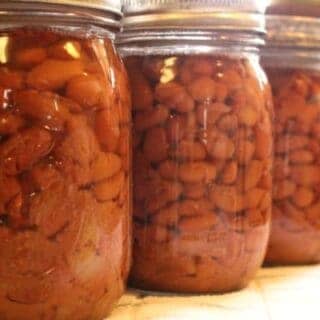
How to Pressure Can Dry Beans
How to prepared and can your own dry beans
Ingredients
- Pinto Beans
- Water
- Salt-optional
- Vinegar- optional
Instructions
- Prepare your beans by soaking overnight or using the quick soak method
- Fill a pot with water, covering the beans by 2 inches. Bring to a boil. Cook and stir for 30 minutes.
- Fill up your pressure canner with water according to the canner instructions and heat until softly boiling. As an optional step, you can add 1/4 cup of white vinegar to the water to eliminate the cloudiness that mineral deposits
- Wash your lids, rings, and jars.
- Heat your jars to reduce cracking
- Fill your jars with beans to a 1 inch head space.
- Ladle hot liquid into the jars to cover beans, maintaining the 1 inch of headspace. Add 1/2 tsp salt per pint if you wish.
- Run a knife along the side of the jars to release air bubbles
- Wipe the rims of the jars with a clean, damp, rag
- Place on lids and rings. Tighten rings finger tight.
- Put the jars in your canner.
- Process at 10lb pressure for 75 minutes for pints, or 90 minutes for quarts. (adjust for altitude if needed)
- Once processing is finished, turn off the heat and leave the canner in place, allowing it to depressurize.
- Open the canner and allow the jars to sit in the canner for 10 minutes.
- Remove the jars and set them in a draft-free place, undisturbed for 24 hours.
- Remove the rings and store.
Notes
All kinds of dry beans can be canned in this method including kidney, pinto, great northern, navy garbanzo and black beans.
The beans must be soaked and heated before placing into jars.
Canning instructions provided by Kristi Stone of Stone Family Farmstead.


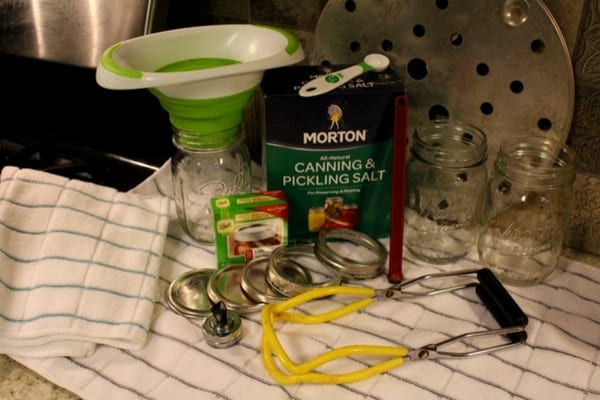
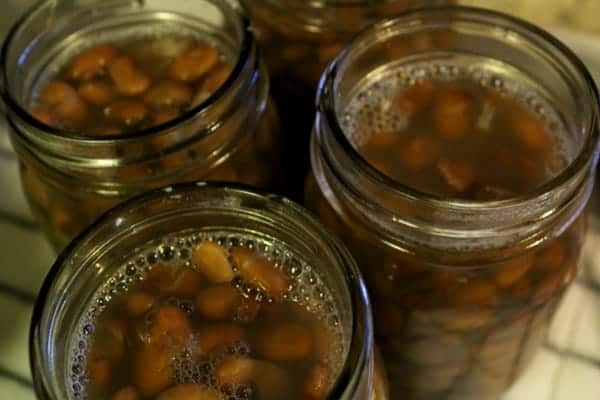
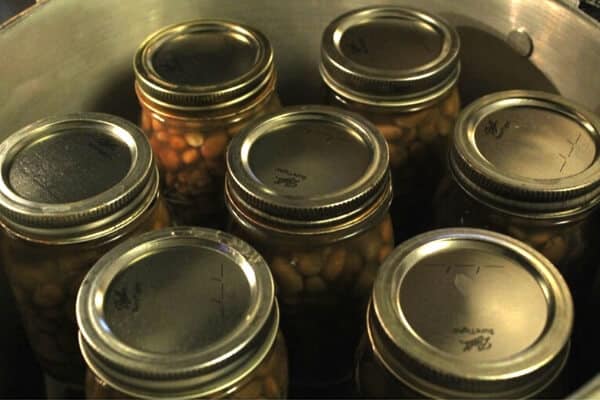
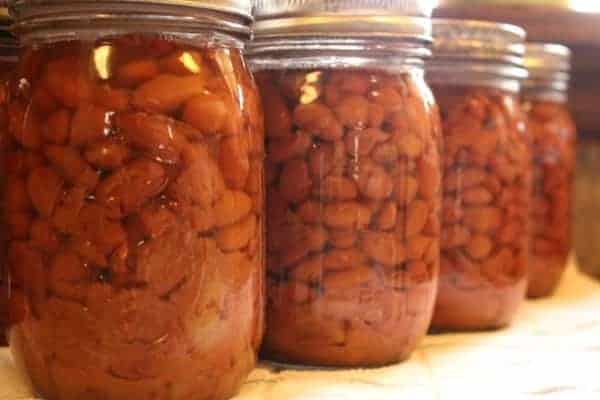
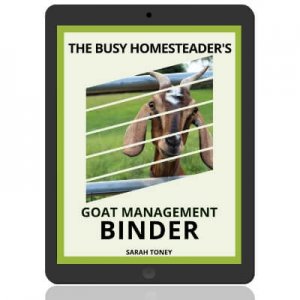
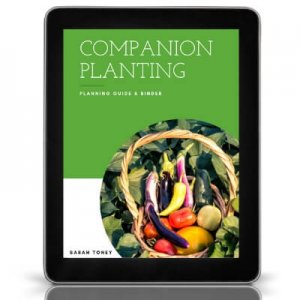
Shared on my Facebook page and will be pinned shortly!
My beans turn to mush when I let them go at 10 lbs of pressure for 90 minutes.
Did yours not do this?
I rinse my beans but don’t soak. Fill jars with hot water. Puts 75min, qt 90min
Great article. I have a stove top American pressure cooker. Pressure cooking qt jars of pintos. My elevation is 178 feet. Would you say 10 pounds of pressure and can for 90 min?
Absolutely
I am new to Canning and want to clarify. I put the jars in a pressure cooker with the lid on. Let it boil for 10 minutes, then put the weight on it for 90 minutes for quart. Then turn the burner off and let the pressure release naturally?
Thank you Christina
Is the canning process/time the same if you add fresh cooked garlic, onion, cilantro and spices to the recipe?
Look at the times for canning garlic, onions, etc. You will pressure can using the one that the time is the longest. If pinto veans are canned longer than garlic or onions, go with the pinto bean time. I hope this makes sense.
All the water boils out of my jars what am I doing wrong
If the lbs of pressure on the gauge fluctuates a lot (high and low) during cooking this can cause bottles to lose liquid.
In all honesty, and not what today says, but how did people that lived in the Hot, Humid South store their jars way back when? Based on what I have read, storing in a non-A/C’ed room will cause spoilage.
Most had a root cellar, basement or a can house.
Do you fill the jar with just beans then add water? Or liquid at same time? Maybe 1/2 jar,beans then water?I’m just not clear on this.
I read your bean canning I did mine the same way and the beans looked just like your over cooked mushy in the bottom. I think 90 minutes is to long at 250 degrees I’ve read everyone’s recipes including Bell’s all the same that’s old thinking I want to know why it takes so long and what’s purpose is that achieving
Tell me what u think
Mike
Great idea! Can you season the beans or add ingredients (ie peppers, onions, garlic, or herbs) before canning? Does it change the processing time?
Can you refrigerate the beans after boiling for 30 minutes and can them the next day? I was so excited to try this recipe and cooked the beans just to realize my canner was missing the pressure gauge so I had to order a replacement that won’t come in until tomorrow. I don’t want to waste the beans.
If you boil your beans for 30 mins prior to canning them , they will be mushy . I just warm mine to the boiling point then stop . They turn out much better .
This sounds good. Perhaps quicksoak
Wash beans, then bring to boil 5 mins. And turn burner off. Let sit 1hr. Then drain water, add fresh water and heat just to boil. Turn off bean pot. And then follow the canning instructions.💖 Still process 90mins for quarts.*
75mins. For pints **
i ACCIDENTALLY PROCESSED THE BEANS FOR 25 MINUTES USING THE PRESSURE CAN METHOD A FEW WEEKS AGO AND JUST REALIZED IT WHEN I RE-READ THE RECIPE TO MAKE MORE. SHOULD I THROW ALL THOSE JARS OUT?
I would just to be on the safe side